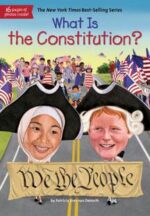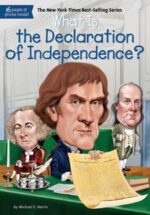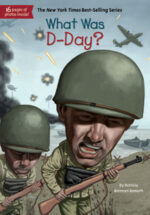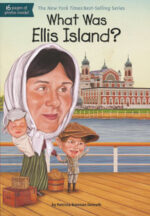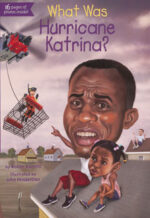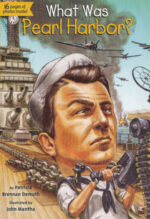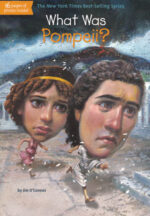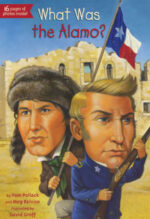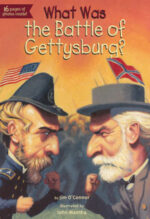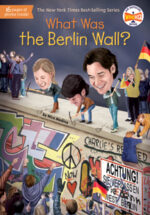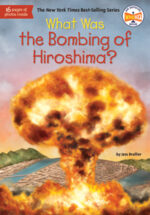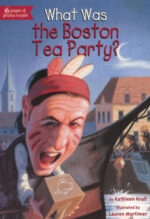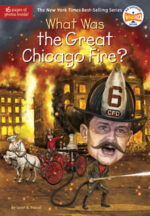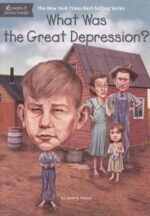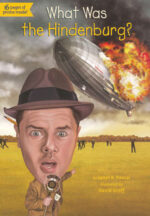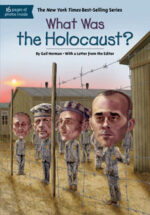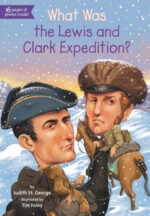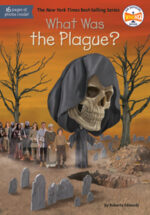History books kids love to read!
Who Was? and What Was? Books for Grades 3 to 7.
180 titles now available!
The Who Was? series is one of the most popular series of books for kids!
Each book is filled with stories about people’s lives and interesting facts that will capture the interest of readers—even reluctant readers. They are perfect for school book fairs and fundraisers and homeschooling.
Each title is previewed for family-friendly content.
-
What Is LEGO? (Jim O’ Connor)
$4.95“Four score and seven years ago…” begins Abraham Lincoln’s beautiful speech commemorating the three-day battle that turned the tide of the Civil War. The South had been winning up to this point. So how did Union troops stop General Robert E. Lee’s invasion of the North? With black-and-white illustrations throughout and sixteen pages of photos, this turning point in history is brought vividly to life.
Recommended for:
Ages: 8-12
Grades: 3-7
Accelerated Reading
$5.99 -
What Is the Constitution?
$5.99Signed on September 17, 1787—four years after the American War for Independence—the Constitution laid out the supreme law of the United States of America. Today it’s easy for us to take this blueprint of our government for granted. But the Framers—fifty-five men from almost all of the original 13 states—argued fiercely for many months over what ended up being only a four-page document. Here is a fascinating behind-the-scenes look at the hotly fought issues—those between Northern and Southern states; big states and little ones—and the key players such as James Madison, Alexander Hamilton, and George Washington who suffered through countless revisions to make the Constitution happen.
-
What Is the Declaration of Independence?
$5.99Step back in time to the birth of America and meet the real-life rebels who made this country free!
On a hot summer day near Philadelphia in 1776, Thomas Jefferson sat at his desk and wrote furiously until early the next morning. He was drafting the Declaration of Independence, a document that would sever this country’s ties with Britain and announce a new nation—The United States of America. Colonists were willing to risk their lives for freedom, and the Declaration of Independence made that official. Discover the true story of one of the most radical and uplifting documents in history and follow the action that fueled the Revolutionary War.
-
What Was D-Day? (Patricia Brennan Demuth)
$4.95In the early morning hours of June 6, 1944, an armada of 7,000 ships carrying 160,000 Allied troops stormed the beaches of Nazi-occupied France. Up until then the Allied forces had suffered serious defeats, yet D-Day, as the invasion was called, spelled the beginning of the end for Nazi Germany and the Third Reich. Readers will dive into the heart of the action and discover how it was planned and carried out and how it overwhelmed the Germans who had been tricked into thinking the attack would take place elsewhere. D-Day was a major turning point in World War II and hailed as one of the greatest military attacks of all time.
Recommended for:
Ages: 8-12
Grades: 2-6
Accelerated Reading
$5.99 -
What Was Ellis Island? (Patricia Brennan Demuth)
$5.95From 1892 to 1954, Ellis Island was the gateway to a new life in the United States for millions of immigrants. In later years, the island was deserted, the buildings decaying. Ellis Island was not restored until the 1980s, when Americans from all over the country donated more than $150 million. It opened to the public once again in 1990 as a museum. Learn more about America’s history, and perhaps even your own, through the story of one of the most popular landmarks in the country.
Recommended for:
Ages: 8-12
Grades: 2-6
Accelerated Reading
$7.99 -
What Was Hurricane Katrina? (Robin Koontz)
$4.95On August 25th, 2005, one of the deadliest and most destructive hurricanes in history hit the Gulf of Mexico. High winds and rain pummeled coastal communities, including the City of New Orleans, which was left under 15 feet of water in some areas after the levees burst. Track this powerful storm from start to finish, from rescue efforts large and small to storm survivors’ tales of triumph.
Recommended for:
Ages: 8-12
Grades: 2-6
Accelerated Reading
$5.99 -
What Was Pearl Harbor? (Patricia Brennan Demuth)
$4.95On December 7, 1941, Japanese war planes appeared out of nowhere to bomb the American base at Pearl Harbor in Hawaii. It was a highly secretive and devastating attack: four battleships sunk, more than two thousand servicemen died, and the United States was propelled into World War II. In a compelling, easy-to-read narrative, children will learn all about a pivotal moment in American history.
Recommended for:
Ages: 8-12
Grades: 2-6
Accelerated Reading
$5.99 -
What Was Pompeii? (Jim O’ Connor)
$4.95The morning of August 24, AD 79, seemed like any other in the Roman city of Pompeii. So no one was prepared when the nearby volcano Mount Vesuvius suddenly erupted, spouting ash that buried the city and its inhabitants. The disaster left thousands dead, and Pompeii was no more than a memory for almost 1,700 years. In 1748, explorers rediscovered the port city with intact buildings and beautiful mosaics. This easy-to-read account is gripping and includes photos of the ruins.
Recommended for:
Ages: 8-12
Grades: 3-7
Accelerated Reading
$5.99 -
What Was the Age of Exploration? (Catherine Daly)
$5.95Land ho! Discover what the Age of Exploration was all about in this wonderful addition to the bestselling Who HQ series!
Before the fifteenth century, European sailors were unsure what waited for them beyond their well-known travel routes around the Mediterranean Sea, so they kept within sight of land. But all of that changed after Prince Henry the Navigator of Portugal started sending ships down the coast in the hope of finding a sea route to India and Africa. This was the beginning of a giant leap toward understanding what the globe actually looked like. Certain European nations grew rich and powerful from the New World gold and lands they claimed, while advanced, long-standing civilizations like the Aztecs and Incas were destroyed in the cruelest of ways.
This book also features the fun black-and-white illustrations and engaging 16-page photo insert that readers have come love about the What Was? series!
Recommended for:
Ages: 8-12
Grades: 2-6
$7.99 -
What Was the Alamo? (Pam Pollack and Meg Belviso)
$4.95“Remember the Alamo!” is still a rallying cry more than 175 years after the siege in Texas, where a small band of men held off about two thousand soldiers of the Mexican Army for twelve days. The Alamo was a crucial turning point in the Texas Revolution, and led to the creation of the Republic of Texas. With 80 black-and-white illustrations throughout and a sixteen-page black-and-white photo insert, young readers will relive this famous moment in Texas history.
Recommended for:
Ages: 8-12
Grades: 2-6
Accelerated Reading
$5.99 -
What Was the Battle of Gettysburg? (Jim O’ Connor)
$4.95“Four score and seven years ago…” begins Abraham Lincoln’s beautiful speech commemorating the three-day battle that turned the tide of the Civil War. The South had been winning up to this point. So how did Union troops stop General Robert E. Lee’s invasion of the North? With black-and-white illustrations throughout and sixteen pages of photos, this turning point in history is brought vividly to life.
Recommended for:
Ages: 8-12
Grades: 2-6
Accelerated Reading
$5.99 -
What Was the Berlin Wall? (Nico Medina)
$4.95Which of these facts are true?
It divided the city of Berlin, separating families and friends for twenty-eight years
Thousands of East Berliners tried to cross into West Berlin, two people escaped by zip line
All around the world, people celebrated when the wall finally began to come down in 1989
All of the above!The Berlin Wall finally came down in 1989. Now readers can find out why it was built in the first place; and what it meant for Berliners living on either side of it. Here’s the fascinating story of a city divided.
In 1961, overnight a concrete border went up, dividing the city of Berlin into two parts – East and West. . The story of the Berlin Wall holds up a mirror to post-WWII politics and the Cold War Era when the United States and the USSR were enemies, always on the verge of war. The wall meant that no one from Communist East Berlin could travel to West Berlin, a free, democratic area. Of course that didn’t stop thousands from trying to breech the wall – more than one hundred of them dying in the attempt. (One East Berliner actually ziplined to freedom!) Author Nico Medina explains the spy-vs-spy politics of the time as well as what has happened since the removal of one of the most divisive landmarks in modern history.
Recommended for:
Ages: 8-12
Grades: 3-7
Accelerated Reading
$5.99 -
What Was the Bombing of Hiroshima? (Jess Brallier)
$4.95What Was the Bombing of Hiroshima?
Hiroshima is where the first atomic bomb was dropped. Now readers will learn the reasons why and what it’s meant for the world ever since.
By August 1945, World War II was over in Europe, but the fighting continued between American forces and the Japanese, who were losing but determined to fight till the bitter end. And so it fell to a new president–Harry S. Truman–to make the fateful decision to drop two atomic bombs–one on Hiroshima and one on Nagasaki–and bring the war to rapid close. Now, even seventy years later, can anyone know if this was the right choice? In a thoughtful account of these history-changing events, Jess Brallier explains the leadup to the bombing, what the terrible results of it were, and how the threat of atomic war has colored world events since.
Recommended for:
Ages: 8-12
Grades: 2-6
$5.99 -
What Was the Boston Tea Party? (Kathleen Krull)
$4.95“No Taxation without Representation!” The Boston Tea Party stands as an iconic event of the American Revolution—outraged by the tax on tea, American colonists chose to destroy the tea by dumping it into the water! Learn all about the famed colonialists who fought against the British Monarchy, and read about this act of rebellion from our history! With black-and-white illustrations throughout and sixteen pages of photos, the Boston Tea party is brought to life!
Recommended for:
Ages: 8-12
Grades: 3-7
Accelerated Reading
$5.99 -
What Was the Great Chicago Fire? (Janet B. Pascal)
$4.95Did the Great Chicago Fire really start after a cow kicked over a lantern in a barn? Find out the truth in this addition to the What Was? series.
On Sunday, October 8, 1871, a fire started on the south side of Chicago. A long drought made the neighborhood go up in flames. And practically everything that could go wrong did. Firemen first went to the wrong location. Fierce winds helped the blaze jump the Chicago River twice. The Chicago Waterworks burned down, making it impossible to fight the fire. Finally after two days, Mother Nature took over, with rain smothering the flames. This overview of a stupendous disaster not only covers the fire but explores the whole history of fire fighting.
Recommended for:
Ages: 8-12
Grades: 2-6
Accelerated Reading
$5.99 -
What Was the Great Depression? (Janet B. Pascal)
$4.95On October 29, 1929, life in the United States took a turn for the worst. The stock market—the system that controls money in America— plunged to a record low. But this event was only the beginning of many bad years to come. By the early 1930s, one out of three people was not working. People lost their jobs, their houses, or both and ended up in shantytowns called “Hoovervilles” named for the president at the time of the crash. By 1933, many banks had gone under. Though the U.S. has seen other times of struggle, the Great Depression remains one of the hardest and most widespread tragedies in American history. Now it is represented clearly and with 80 illustrations in our What Was…? series.
Recommended for:
Ages: 8-12
Grades: 2-6
Accelerated Reader: Yes
$5.99 -
What Was the Hindenburg? (Janet B. Pascal)
$4.95At 800-feet long, the Hindenburg was the largest airship ever built–just slightly smaller than the Titanic! Also of a disastrous end, the zeppelin burst into flame as spectators watched it attempt to land in Lakehurst, New Jersey on May 6, 1937. In under a minute, the Hindenburg was gone, people jumping from windows to escape. However, only 62 of the 97 crew members and passengers onboard survived. The exact cause of the disaster is still unknown and remains a fascinating historical mystery perfect for this series.
Recommended for:
Ages: 8-12
Grades: 2-6
Accelerated Reading
$5.99 -
What Was the Holocaust? (Gail Herman)
$4.95The Holocaust was a genocide on a scale never before seen, with as many as twelve million people killed in Nazi death camps—six million of them Jews. Gail Herman traces the rise of Hitler and the Nazis, whose rabid anti-Semitism led first to humiliating anti-Jewish laws, then to ghettos all over Eastern Europe, and ultimately to the Final Solution. She presents just enough information for an elementary-school audience in a readable, well-researched book that covers one of the most horrible times in history.
This entry in the New York Times best-selling series contains eighty carefully chosen illustrations and sixteen pages of black and white photographs suitable for young readers.
Recommended for:
Ages: 8-12
Grades: 2-6
Accelerated Reading
$5.99 -
What Was the Lewis and Clark Expedition? (Judith St. George)
$4.95When Meriwether Lewis, William Clark, and the “Corp of Discovery” left St. Louis, Missouri, on May 21, 1804, their mission was to explore the vast, unknown territory acquired a year earlier in the Louisiana Purchase. The travelers hoped to find a waterway that crossed the western half of the United States. They didn’t. However, young readers will love this true-life adventure tale of the two-year journey that finally brought the explorers to the Pacific Ocean.
Recommended for:
Ages: 8-12
Grades: 3-7
Accelerated Reading
$5.99 -
What Was the Plague? (Roberta Edwards)
$4.95Which of these facts are true?
It is a deadly disease spread by bacteria-infected fleas
In the fourteenth century, plague spread through Asia, Africa, and Europe and may have killed more than twenty-five million people
The second wave was one of the deadliest pandemics in human historyOh, rats! It’s time to take a deeper look at what caused the Black Death–the deadliest pandemic recorded in human history.
While the coronavirus COVID-19 changed the world in 2020, it still isn’t the largest and deadliest pandemic in history. That title is held by the Plague. This disease, also known as the “Black Death,” spread throughout Asia, Africa, and Europe in the fourteenth century and claimed an astonishing 50 million lives by the time it officially ended. Author Roberta Edwards takes readers back to these grimy and horrific years, explaining just how this pandemic began, how society reacted to the disease, and the impact it left on the world.
With 80 black-and-white illustrations and an engaging 16-page photo insert, readers will be excited to read this latest addition to Who HQ!
Recommended for:
Ages: 8-12
Grades: 2-6
$5.99


